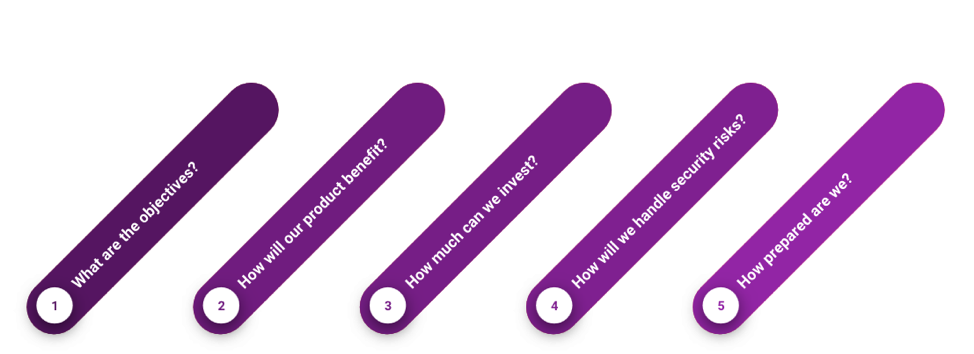Comments (4)
Todd Coen
This is a great piece that leaves the reader more loaded in terms of IoT prowess. Great one!
Daniel Murray
Great article and so relevant !
Lucy Wardle
Great article, quite enlightening
Jordan Carter
Brilliant

Asking and answering the right questions before enterprise level IoT deployment will help make the process free of dilemmas and allow organizations to set realistic expectations right from the beginning.
Knowing the potential benefits of IoT, investing in it looks like the most logical move for any business looking to build for the future. However, there are certain factors that need to be taken into consideration. You need to evaluate your IoT strategy, as well as your capability to execute it. Implementation without a thorough analysis may lead to many complications during IoT deployment, leading to less than ideal results. Asking, and contemplatively answering, the following questions will give more clarity regarding IoT goals and expectations, enabling an easy transition towards IoT.

Complete integration of IoT with the existing business processes will improve every aspect of the business. However, achieving the potential benefits of IoT requires a complete re-engineering of the business model to incorporate IoT. IoT technology is not only complex, but also quite dynamic at this stage, with novelties becoming obsolete in a matter of months, making complete integration highly risky. Hence, the focus of enterprises initially should be on high priority performance aspects. For instance, a manufacturing company could focus on IoT enabled asset management to maximize equipment utilization as the initial project, or a service provider could implement IoT only to improve customer engagement. The prioritization of area for improvement should be done by considering the organization’s overall strategy and vision, and the KPIs it values the most.
An important consideration before implementing enterprise IoT is the impact of the change being undertaken, on the product or service offered by the organization. Disney’s $1bn investment in MagicBands, an IoT enabled wristband that enables customers to have personalized experiences and quick access to park features, is an example of IoT used to enhance customer service. The ultimate aim for any enterprise-wide change should be to increase the value of the organization’s offerings. Thus, the capability that will most significantly impact the product value should be prioritized for development through IoT.
Transitioning a business towards IoT integration would require substantial capital, at least during the initial stages of deployment. Thus, it is necessary for organizations to consider the financial constraints before IoT deployment. The potential total investment to acquire and install IoT enabled end-points and networks is broadly variable. It mainly depends on the compatibility of the existing IT infrastructure with the proposed additions, and the need for custom or off-the-shelf hardware and software, among other case-specific factors. Performing a thorough analysis of the current financial capability of the business, the degree of change proposed, and the corresponding expenses, along with cost-to-benefit and break-even point analysis would give the organization a clearer picture of IoT readiness with respect to investment requirements.
Running a business on IoT undoubtedly comes with many benefits, but it also comes with a few challenges, the foremost being security. An IoT network, where data is constantly collected and shared without much regulation, increases the chances of sensitive data inadvertently ending up in the hands of undesirable parties. The data on IoT is also vulnerable to deliberate theft and modification, which makes conducting business on IoT considerably risky. A research suggests that data breaches will cost businesses over $8 trillion between 2017 and 2022. Hence, it is important for businesses contemplating IoT deployment to assess, plan, and fortify their cybersecurity strategy. Being aware of a cyber risk, finding ways to combat it, and having a well-formulated security protocol will help mitigate the risk of losing sensitive data and ensure a more secure business process.
It is important to evaluate the overall IoT-readiness of the organization to manage expectations and plan the future appropriately. During this evaluation, elements such as existing IT infrastructure, IoT knowledge base, and other resources, including finance, should be considered.
Another important consideration before IoT implementation is to know whether the entire organization is on-board with the IoT integration plans or not. Ensuring the buy-in of all participating members of the organization is the key in determining the ease with which IoT integration is brought about in the business, as it is with any proposed major change.
IoT deployment requires a clear vision and a thoroughly planned roadmap for maximum effectiveness and minimum risks. Since it is a highly disruptive endeavor, every step should be taken with well informed certainty, and asking the above questions will direct you on the right track.
This is a great piece that leaves the reader more loaded in terms of IoT prowess. Great one!
Great article and so relevant !
Great article, quite enlightening
Brilliant
Naveen is the Founder and CEO of Allerin, a software solutions provider that delivers innovative and agile solutions that enable to automate, inspire and impress. He is a seasoned professional with more than 20 years of experience, with extensive experience in customizing open source products for cost optimizations of large scale IT deployment. He is currently working on Internet of Things solutions with Big Data Analytics. Naveen completed his programming qualifications in various Indian institutes.
Leave your comments
Post comment as a guest